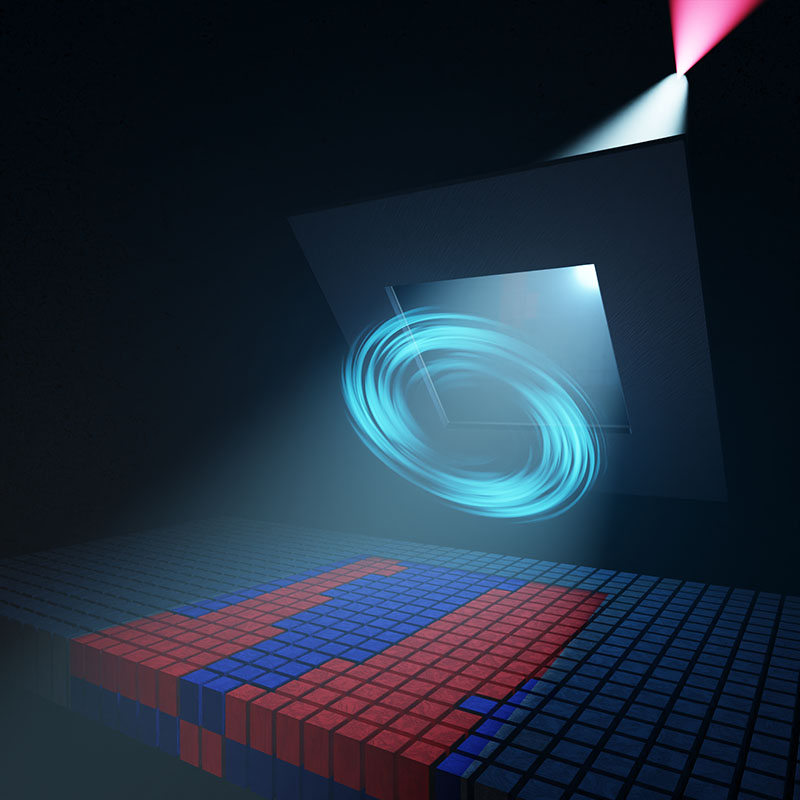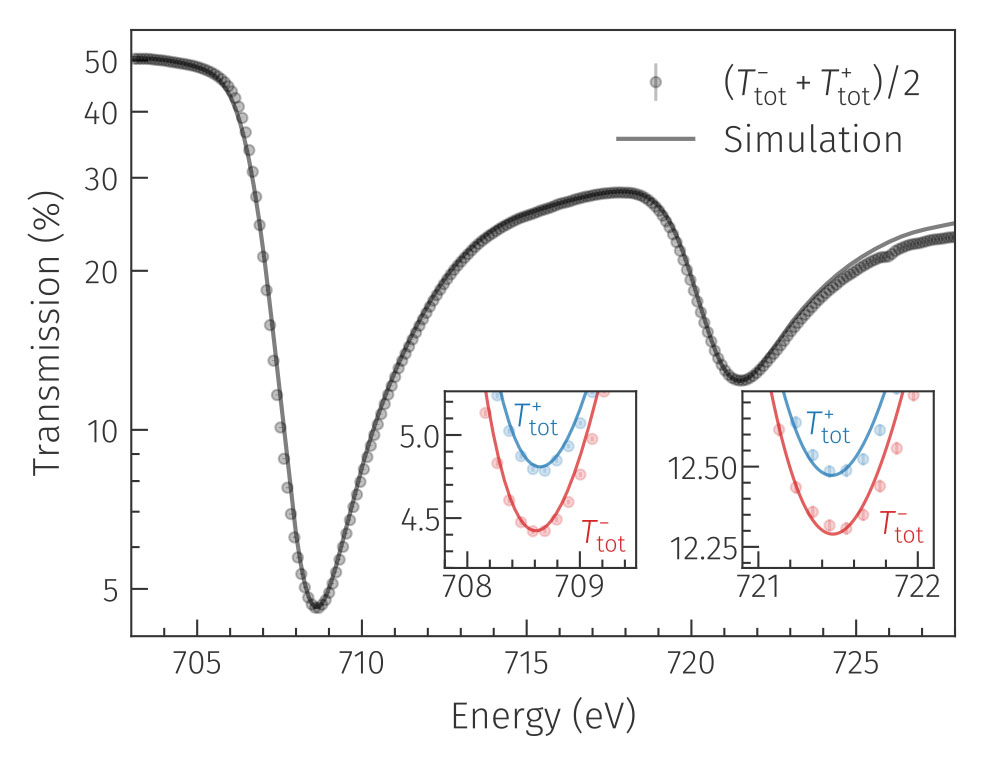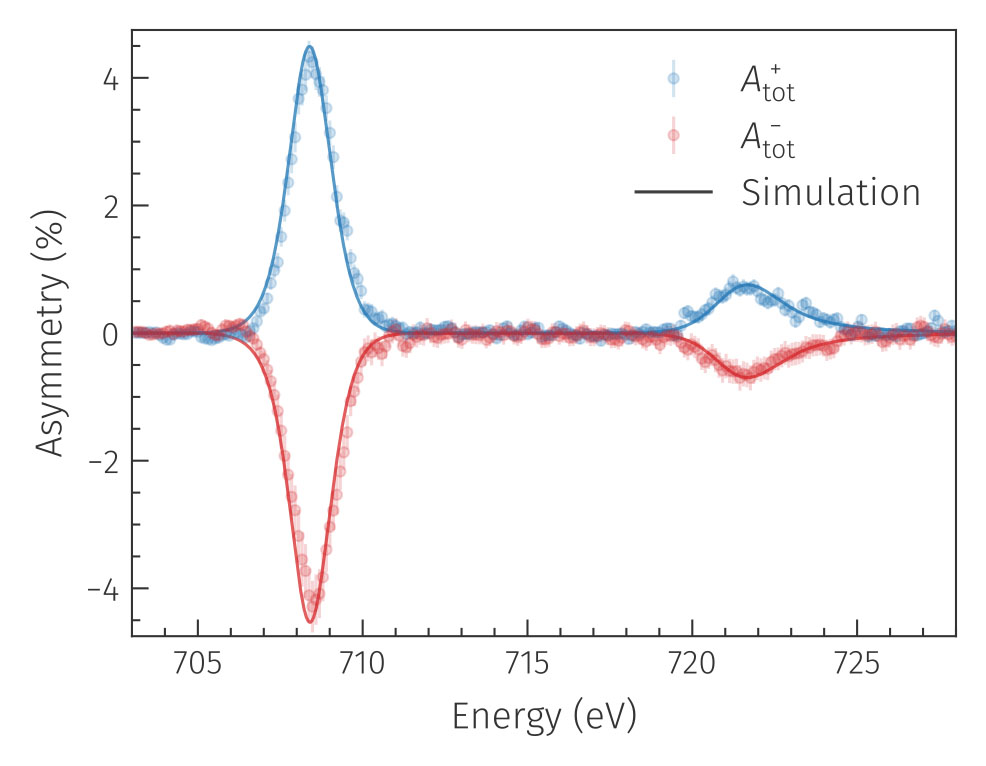| Apr 05, 2023 |
Looking at nanomagnets in the right light
(Nanowerk News) Magnetic nanostructures have long permeated our daily lives, manifesting as swift and compact data storage devices or highly sensitive sensors. A crucial tool for understanding many relevant magnetic effects and functions is X-ray Magnetic Circular Dichroism (XMCD), a sophisticated term that denotes a fundamental interaction between light and matter.
|
|
In ferromagnetic materials, electrons with a specific angular momentum, known as spin, are imbalanced. When circularly polarized light, possessing a defined angular momentum, passes through a ferromagnet, a distinct difference in transmission occurs based on the parallel or anti-parallel alignment of the two angular momenta—a phenomenon called dichroism.
|
 |
| Artist's impression of the XMCD experiment. The soft-x-ray light from a plasma source is first circularly polarized by the transmission through a magnetic film. Subsequently, the magnetization in the actual sample can be determined accurately. (Image: Christian Tzschaschel)
|
|
This magnetic circular dichroism is particularly pronounced in the soft-x-ray region (200 to 2000 eV energy of light particles, corresponding to a wavelength of merely 6 to 0.6 nm). This region includes element-specific absorption edges of transition metals like iron, nickel, and cobalt, as well as rare earth elements such as dysprosium and gadolinium, all of which are crucial for harnessing magnetic effects in technical applications.
|
|
The XMCD effect facilitates the precise determination of magnetic moments for these elements, even in concealed layers of a material, without damaging the sample system. With circularly polarized soft-x-ray radiation arriving in extremely brief femto- to picosecond pulses, ultrafast magnetization processes can be monitored at relevant time scales.
|
|
Until now, access to the necessary x-ray radiation has been limited, only attainable at scientific large-scale facilities, such as synchrotron-radiation sources or free-electron lasers (FELs).
|
|
A research team led by junior research group leader Daniel Schick at Berlin's Max Born Institute (MBI) has pioneered XMCD experiments at iron's absorption L edges at a photon energy of approximately 700 eV in a laser laboratory.
|
 |
| The averaged transmission through the investigated sample at the Fe L absorption edges (black data points) can be measured precisely and is well described by a simulation (black line). At the two absorption maxima, see insets, significant dichroism for the two different directions of saturation magnetization of the sample is observable. So far, such experiments have only been possible at large-scale facilities. (Image: FVB)
|
|
The team employed a laser-driven plasma source to generate the necessary soft x-ray light by focusing short (2 ps) and intense (200 mJ per pulse) optical laser pulses onto a tungsten cylinder. The resulting plasma emits abundant light in the relevant 200-2000 eV spectral range, with a pulse duration of less than 10 ps.
|
|
However, due to the stochastic generation process within the plasma, a crucial requirement for observing XMCD is unmet—the soft-x-ray light's polarization is random, akin to a light bulb, rather than circular as needed. To overcome this obstacle, the researchers employed a magnetic polarization filter, utilizing the same XMCD effect as described earlier.
|
|
The polarization-dependent dichroic transmission creates an imbalance of light particles with parallel vs. anti-parallel angular momentum in relation to the filter's magnetization. After passing through the polarization filter, the partially circularly or elliptically polarized soft-x-ray light is suitable for the actual XMCD experiment on a magnetic sample.
|
 |
| Magnetic asymmetry behind the polarizer and the examined sample at the Fe L absorption edges. The two colors correspond to measurements with reversed magnetization of the polarizer - the magnetization direction of the sample is immediately evident from the sign of the dichroism observed (blue vs. red curve). The measurements can be reproduced very accurately by simulations (lines). (Image: FVB)
|
|
Published in the scientific journal Optica ("X-ray magnetic circular dichroism spectroscopy at the Fe L edges with a picosecond laser-driven plasma source"), this groundbreaking work illustrates that laser-based x-ray sources are advancing to compete with large-scale facilities.
|
|
"Our concept for generating circularly polarized soft x-rays is not only highly flexible, but also surpasses conventional methods in XMCD spectroscopy, thanks to the broadband nature of our light source," says the study's first author and MBI PhD student, Martin Borchert.
|
|
Specifically, the demonstrated pulse duration of the generated x-ray pulses, lasting only a few picoseconds, paves the way for novel opportunities to observe and ultimately comprehend rapid magnetization processes, such as those initiated by ultrashort light flashes.
|



